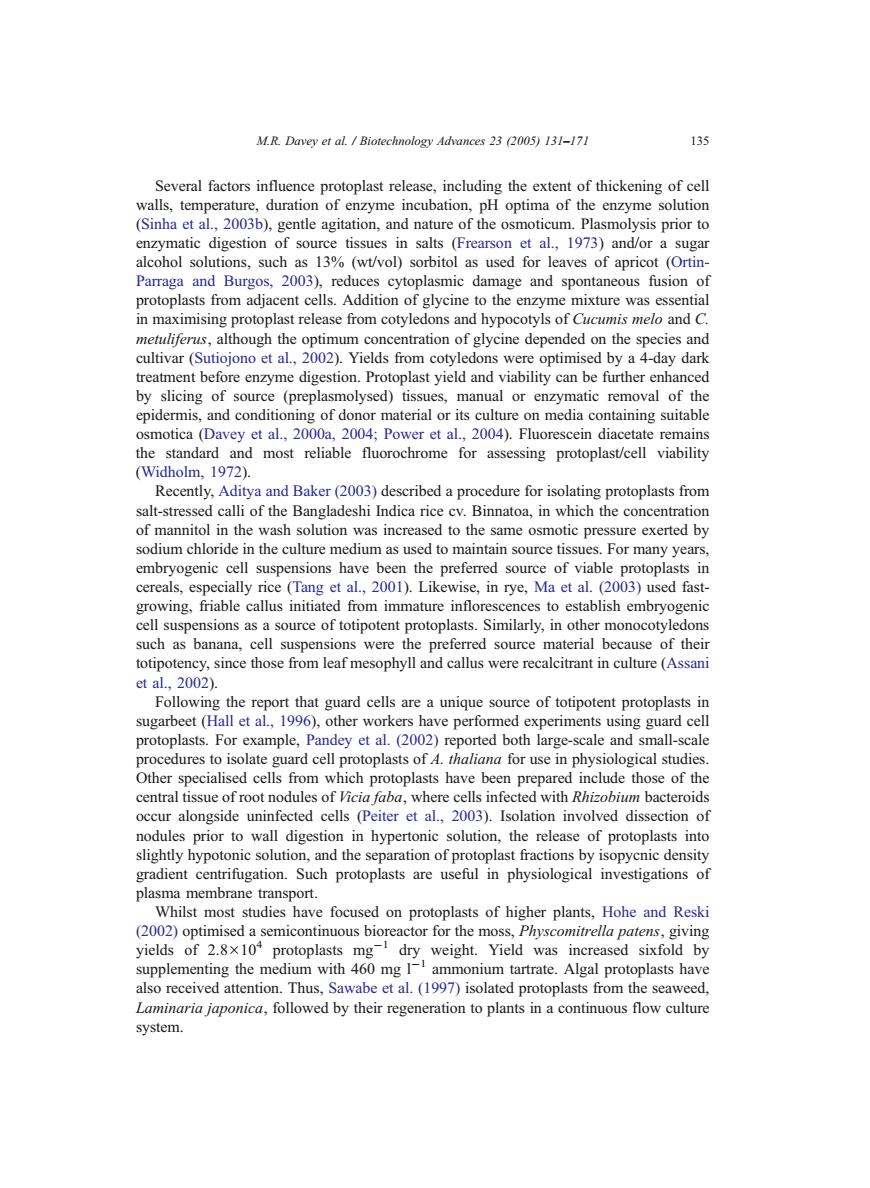正在加载图片...

M.R.Davey et al.Biotechnology Advances 23 (2005)131-171 135 Several factors influence protoplast release,including the extent of thickening of cell walls,temperature,duration of enzyme incubation,pH optima of the enzyme solution (Sinha et al.,2003b),gentle agitation,and nature of the osmoticum.Plasmolysis prior to enzymatic digestion of source tissues in salts (Frearson et al.,1973)and/or a sugar alcohol solutions,such as 13%(wt/vol)sorbitol as used for leaves of apricot (Ortin- Parraga and Burgos,2003),reduces cytoplasmic damage and spontaneous fusion of protoplasts from adjacent cells.Addition of glycine to the enzyme mixture was essential in maximising protoplast release from cotyledons and hypocotyls of Cucumis melo and C. metuliferus,although the optimum concentration of glycine depended on the species and cultivar(Sutiojono et al.,2002).Yields from cotyledons were optimised by a 4-day dark treatment before enzyme digestion.Protoplast yield and viability can be further enhanced by slicing of source (preplasmolysed)tissues,manual or enzymatic removal of the epidermis,and conditioning of donor material or its culture on media containing suitable osmotica (Davey et al.,2000a,2004;Power et al.,2004).Fluorescein diacetate remains the standard and most reliable fluorochrome for assessing protoplast/cell viability (Widholm,1972). Recently,Aditya and Baker(2003)described a procedure for isolating protoplasts from salt-stressed calli of the Bangladeshi Indica rice cv.Binnatoa,in which the concentration of mannitol in the wash solution was increased to the same osmotic pressure exerted by sodium chloride in the culture medium as used to maintain source tissues.For many years, embryogenic cell suspensions have been the preferred source of viable protoplasts in cereals,especially rice (Tang et al.,2001).Likewise,in rye,Ma et al.(2003)used fast- growing,friable callus initiated from immature inflorescences to establish embryogenic cell suspensions as a source of totipotent protoplasts.Similarly,in other monocotyledons such as banana,cell suspensions were the preferred source material because of their totipotency,since those from leaf mesophyll and callus were recalcitrant in culture(Assani etal,2002). Following the report that guard cells are a unique source of totipotent protoplasts in sugarbeet(Hall et al.,1996),other workers have performed experiments using guard cell protoplasts.For example,Pandey et al.(2002)reported both large-scale and small-scale procedures to isolate guard cell protoplasts of 4.thaliana for use in physiological studies Other specialised cells from which protoplasts have been prepared include those of the central tissue of root nodules of Vicia faba,where cells infected with Rhizobium bacteroids occur alongside uninfected cells (Peiter et al.,2003).Isolation involved dissection of nodules prior to wall digestion in hypertonic solution,the release of protoplasts into slightly hypotonic solution,and the separation of protoplast fractions by isopycnic density gradient centrifugation.Such protoplasts are useful in physiological investigations of plasma membrane transport. Whilst most studies have focused on protoplasts of higher plants,Hohe and Reski (2002)optimised a semicontinuous bioreactor for the moss,Physcomitrella patens,giving yields of 2.8x10*protoplasts mg dry weight.Yield was increased sixfold by supplementing the medium with 460 mg I ammonium tartrate.Algal protoplasts have also received attention.Thus,Sawabe et al.(1997)isolated protoplasts from the seaweed, Laminaria japonica,followed by their regeneration to plants in a continuous flow culture system.Several factors influence protoplast release, including the extent of thickening of cell walls, temperature, duration of enzyme incubation, pH optima of the enzyme solution (Sinha et al., 2003b), gentle agitation, and nature of the osmoticum. Plasmolysis prior to enzymatic digestion of source tissues in salts (Frearson et al., 1973) and/or a sugar alcohol solutions, such as 13% (wt/vol) sorbitol as used for leaves of apricot (OrtinParraga and Burgos, 2003), reduces cytoplasmic damage and spontaneous fusion of protoplasts from adjacent cells. Addition of glycine to the enzyme mixture was essential in maximising protoplast release from cotyledons and hypocotyls of Cucumis melo and C. metuliferus, although the optimum concentration of glycine depended on the species and cultivar (Sutiojono et al., 2002). Yields from cotyledons were optimised by a 4-day dark treatment before enzyme digestion. Protoplast yield and viability can be further enhanced by slicing of source (preplasmolysed) tissues, manual or enzymatic removal of the epidermis, and conditioning of donor material or its culture on media containing suitable osmotica (Davey et al., 2000a, 2004; Power et al., 2004). Fluorescein diacetate remains the standard and most reliable fluorochrome for assessing protoplast/cell viability (Widholm, 1972). Recently, Aditya and Baker (2003) described a procedure for isolating protoplasts from salt-stressed calli of the Bangladeshi Indica rice cv. Binnatoa, in which the concentration of mannitol in the wash solution was increased to the same osmotic pressure exerted by sodium chloride in the culture medium as used to maintain source tissues. For many years, embryogenic cell suspensions have been the preferred source of viable protoplasts in cereals, especially rice (Tang et al., 2001). Likewise, in rye, Ma et al. (2003) used fastgrowing, friable callus initiated from immature inflorescences to establish embryogenic cell suspensions as a source of totipotent protoplasts. Similarly, in other monocotyledons such as banana, cell suspensions were the preferred source material because of their totipotency, since those from leaf mesophyll and callus were recalcitrant in culture (Assani et al., 2002). Following the report that guard cells are a unique source of totipotent protoplasts in sugarbeet (Hall et al., 1996), other workers have performed experiments using guard cell protoplasts. For example, Pandey et al. (2002) reported both large-scale and small-scale procedures to isolate guard cell protoplasts of A. thaliana for use in physiological studies. Other specialised cells from which protoplasts have been prepared include those of the central tissue of root nodules of Vicia faba, where cells infected with Rhizobium bacteroids occur alongside uninfected cells (Peiter et al., 2003). Isolation involved dissection of nodules prior to wall digestion in hypertonic solution, the release of protoplasts into slightly hypotonic solution, and the separation of protoplast fractions by isopycnic density gradient centrifugation. Such protoplasts are useful in physiological investigations of plasma membrane transport. Whilst most studies have focused on protoplasts of higher plants, Hohe and Reski (2002) optimised a semicontinuous bioreactor for the moss, Physcomitrella patens, giving yields of 2.8104 protoplasts mg1 dry weight. Yield was increased sixfold by supplementing the medium with 460 mg l1 ammonium tartrate. Algal protoplasts have also received attention. Thus, Sawabe et al. (1997) isolated protoplasts from the seaweed, Laminaria japonica, followed by their regeneration to plants in a continuous flow culture system. M.R. Davey et al. / Biotechnology Advances 23 (2005) 131–171 135��